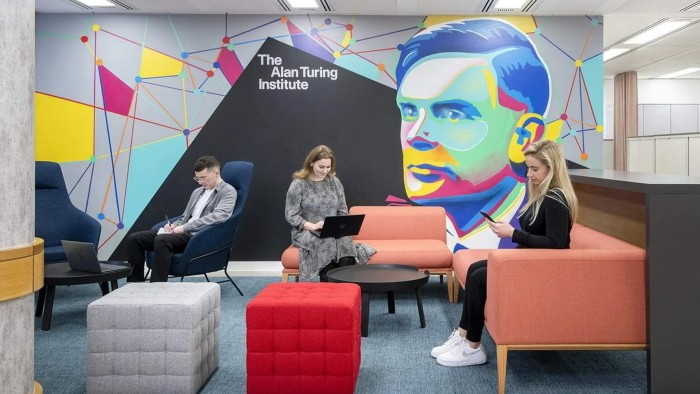Britain’s flagship artificial intelligence agency will slash the number of projects it backs and prioritise work on defence, environment and health as it seeks to respond to technological advances and criticism of its record.
The Alan Turing Institute — named after the pioneering British computer scientist — will shut or offload almost a quarter of its 101 current initiatives and is considering job cuts as part of a change programme that led scores of staff to write a letter expressing their loss of confidence in the leadership in December.
Jean Innes, appointed chief executive in July 2023, argued that huge advances in AI meant the Turing needed to modernise after being founded as a national data science institute by David Cameron’s government a decade ago this month.
“The Turing has chalked up some really great achievements,” Innes said in an interview. “[But we need] a big strategic shift to a much more focused agenda on a small number of problems that have an impact in the real world.”
A review last year by UK Research and Innovation, the government funding body, found “a clear need for the governance and leadership structure of the Institute to evolve”. It called for a move away from the dominance of universities to a structure more representative of AI in UK.
The institute has judged that only 22 of its projects are “aligned or are suitable to be realigned” with its future direction, it said in a statement. Of the others, 49 will be completed at the Turing, 21 will be closed and four transferred elsewhere, while decisions on the last five are on hold.
No redundancies have yet been confirmed, it added, and the Turing “will make every effort to redeploy” members of its 440-strong staff whose jobs were at risk.
The transformation known as Turing 2.0 and its threat to jobs have unsettled many staff. In December, a reported 93 of them signed a letter accusing Innes and executives she had appointed of squandering goodwill, putting the institute’s viability in question.
Innes, who trained as a chemist and has worked at the Treasury and Amazon, said she did not recognise the characterisation of the Turing as suffering from low morale and a widespread lack of confidence in its leadership.
“It is a significant transformation and these processes are really unsettling,” she said. “But we’ve gone through a very thorough consultative procedure.”
She insisted that the underlying motive of the change programme was not to downsize or save money. The Turing has a core government grant of £100mn for the next five years and expects to receive at least £100mn more from other public, private and philanthropic sources over that period.
A key source of additional funds will be UK defence and intelligence institutions, such as GCHQ, MI5 and Defence Science and Technology Laboratory, to support the Turing’s newest and fastest-growing mission — “autonomous defence of our critical national infrastructure”.

The Turing’s immediate surroundings are a reminder of the rising danger of ever more sophisticated digital warfare by hostile governments and criminal gangs. The institute is housed in the British Library, which is still dealing with the fallout from a devastating October 2023 cyber attack.
Although much of the defence and security work is confidential or classified, it also has a public face in the form of the Turing Centre for Emerging Technology and Security, which publishes research.
Its most recent work, carried out with the US-based Special Competitive Studies Project, called for the UK and US national security communities to invest in co-ordinated data collection and AI development. This would help to warn of coming crises and find ways to stabilise conflict.
The aggressive policies of President Donald Trump’s administration on trade and territory have called into doubt US collaboration with historical allies. But Innes said she was confident that the “close working relationship with all of the ‘five eyes’ countries” — UK, US, Canada, Australia and New Zealand — would continue. “We have a very deep relationship with our partners [in the US] and, while the world is changing, I think that level of collaboration stays strong.”
A recent highlight of the Turing’s “environment and sustainability” mission was the release of an AI weather forecasting model that can make accurate predictions on the basis of observations alone, without needing to solve physics-based equations with a supercomputer.
In health, the most advanced project is constructing “cardiac digital twins” — computer models of individual human hearts that can be used to monitor people with cardiovascular disease. “They would have the equivalent of an expert clinician on their shoulder, just watching out for them,” Innes said.

Software and AI engineers are in short supply worldwide and the commercial sector offers remuneration well beyond the scope of public bodies. But Doug Gurr, chair of the Turing board, said he was confident the institute would be able to recruit specialists in these areas.
“Our proposition is that, while you can get more by going across the road to a large tech company, what you get here is the opportunity to work on some of the most interesting problems that will make a real impact on the world,” Gurr said. As employment becomes more fluid, talented AI experts could expect to work three to five years at the institute — long enough to help bring a project to fruition — and then perhaps move into a well-paid corporate job.
The Turing chair is one of several high-profile roles held by Gurr, a former head of Amazon UK. He is Natural History Museum director and interim chair of the Competition and Markets Authority. He was brought in to the CMA in January as part of government efforts to push regulators to promote economic growth.
Asked it was possible to do the three jobs at once, Gurr joked that he was “unbelievably good at time management”.
“At the moment, I think it’s manageable,” he added. “But we’ll see how it goes.”
